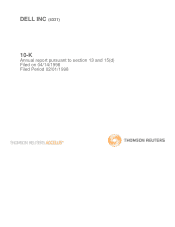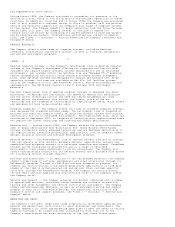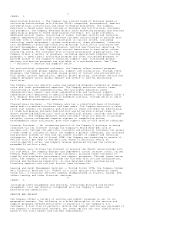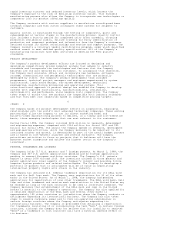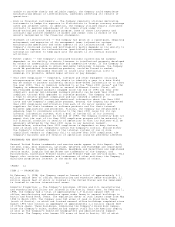Dell 1997 Annual Report Download - page 9
Download and view the complete annual report
Please find page 9 of the 1997 Dell annual report below. You can navigate through the pages in the report by either clicking on the pages listed below, or by using the keyword search tool below to find specific information within the annual report.- General economic and industry conditions -- Any general economic, business or
industry conditions that cause customers or potential customers to reduce or
delay their investments in computer systems could have a negative effect on
the Company's strength and profitability. For example, a softening of demand
for computer systems may result in decreased revenues (or at least declining
revenue growth rates) for computer manufacturers in general and the Company in
8
<PAGE> 10
particular and may result in pricing pressures for products that the Company
sells, which could have a negative effect on the Company's revenues and
profitability.
- Competition -- The computer industry is highly competitive. Some of the
Company's competitors have stronger brand-recognition, greater financial,
marketing, manufacturing and technological resources, broader product lines
and larger installed customer bases than does the Company. The intense
competition inherent in the industry could result in loss of customers or
pricing pressures, which would negatively affect the Company's results of
operations.
- International activities -- The Company's future growth rates and success are
partly dependent on continued growth and success in international markets. As
is the case with most international operations, the success and profitability
of the Company's international operations are subject to numerous risks and
uncertainties, including local economic and labor conditions, political
instability, tax laws (including U.S. taxes on foreign operations) and foreign
currency exchange rates.
- Product, customer and geographic mix -- The profit margins realized by the
Company vary somewhat among its products, its customer segments and its
geographic markets. Consequently, the overall profitability of the Company's
operations in any given period is partially dependent on the product, customer
and geographic mix reflected in that period's net sales.
- Seasonal trends -- The Company experiences some seasonal trends in the sale of
its products. For example, sales to governments (particularly U.S. federal
sales) are often stronger in the Company's third quarter, European sales are
often weaker in the third quarter and consumer sales are often stronger in the
fourth quarter. Historically, the net result of seasonal trends has not been
material relative to the Company's overall results of operations, but many of
the factors that create and affect seasonal trends are beyond the Company's
control.
- Technological changes and product transitions -- The computer industry is
characterized by continuing improvements in technology, which result in the
frequent introduction of new products, short product life cycles and continual
improvement in product price/performance characteristics. While the Company
believes that its direct business model and asset management practices afford
it an inherent competitive advantage over some of its competitors, product
transitions present some of the greatest executional challenges and risks for
any computer systems company. A failure on the part of the Company to
effectively manage a product transition will directly affect the demand for
the Company's products and the profitability of the Company's operations. In
addition, while the Company has meaningful relationships with some of the
world's most advanced technology companies, continuing technological
advancement, which is a significant driver of customer demand, is largely
beyond the control of the Company.
- Inventory levels -- The Company's direct business model gives it the ability
to operate with reduced levels of component and finished goods inventories,
and the Company's financial success in recent periods has been due in part to
its asset management practices, including its ability to achieve rapid
inventory turns. The Company's ability to aggressively manage its inventory
has been enhanced by favorable supply conditions in the industry. Less
favorable supply conditions, as well as other factors beyond the Company's
control, may require or result in increased inventory levels in the future.
- Supply sources -- The Company's manufacturing process requires a high volume
of quality components that are procured from third party suppliers. Reliance
on suppliers, as well as industry supply conditions, generally involves
several risks, including the possibility of defective parts (which can
adversely affect the reliability and reputation of the Company's products), a
shortage of components and reduced control over delivery schedules (which can
adversely affect the Company's manufacturing efficiencies) and increases in
component costs (which can adversely affect the Company's profitability).
The Company has several single-sourced supplier relationships, either because
alternative sources are not available or the relationship is advantageous due
to performance, quality,
9
<PAGE> 11
support, delivery, capacity or price considerations. If these sources are

